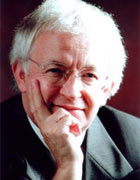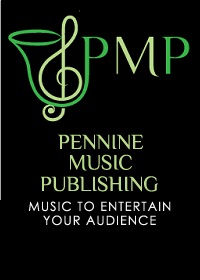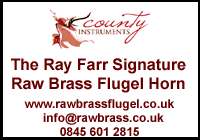2008 British Open Championships - Test Piece Review - Rococo Variations
3-Sep-2008Paul Hindmarsh has been talking to Edward Gregson about his new work for the Open Championship the background to its composition and the musical detail.
 It is seventeen years since Edward Gregson last provided a major brass band work for competitive use. For a composer steeped in the brass band tradition as a young man, this is far too long a gap for some.
It is seventeen years since Edward Gregson last provided a major brass band work for competitive use. For a composer steeped in the brass band tradition as a young man, this is far too long a gap for some.
Steady stream
The steady stream of works that propelled him to the forefront of banding in the late 1960s and 70s are still performed with regularity and the two that brought that productive period to an end - ‘Connotations’ and ‘Variations on Laudate Dominum’ - are among his most often performed works in any genre.
But after that his work-list becomes more wide-ranging and for my part more balanced, with orchestral, choral and chamber music taking centre stage and his two further test pieces ‘Dances and Arias’ and ‘Of Men and Mountains’ following at seven year intervals.
Looking back
Looking back to those early years, Gregson felt that he’d said all that he could in the band medium. The one exception was ‘Trumpets of the Angels’, which was by far his most ambitious brass band work – twenty minutes long, with organ and full of antiphonal effects.
Free of the constraints of the contesting tradition, something, which I feel sometimes weighs rather heavily on the earlier works, Gregson produced his finest essay for brass to date.
By the time ‘Trumpets of the Angels’ was written in 2000, Gregson was well established in Manchester as Principal of the Royal Northern College of Music. Time for composition was at a premium, and he devoted most of those precious hours to completing a series of Concertos – beautifully crafted and scored, full of colour, energy and lyricism.
Each one follows a distinctive musical path, expanding an already well-honed technique with some deliberate references, in effect acts of music homage, to some of the 20th century masters he most admires. (The concertos for Clarinet, Violin, Trumpet, Piano and Saxophone have been recorded by the BBC Philharmonic on the Chandos label).
Indeed, ‘Trumpets of the Angels’ began life as a short orchestral and choral work written as a tribute to the great French composer Olivier Messaien, the centenary of whose birth is being celebrated this year.
Creative possibilities
It’s clear from talking to Edward Gregson about his brass band music, that writing ‘Trumpets of the Angels’ for Foden’s Centenary concert in 2000 opened fresh creative possibilities for him: “…the chance to create a new extended work which would break out of the brass band mould was an important milestone for me.”
During the writing of his wonderful ‘Saxophone Concerto’ (2006), Gregson came up with what he described as a ‘slab of material’ which he knew would not fit into that work. But I recall him saying at the time that with a bit of tweaking it had the makings of a great brass band piece.
Although he had steadfastly turned down invitations to write a new test piece since ’Of Men and Mountains’ was rejected for the National Finals, the opportunity which the eventual invitation from the Open Championship and the Norwegian Band Federation provided was too good an opportunity to turn down and ‘Rococo Variations’ is the result.
Deceptive
On the face of it the title of the latest work – ‘Rococo Variations’ – might suggest some kind of retrenchment back into to creative ‘comfort-zone’ of the 1970s. But titles can be deceptive.
Gregson takes his elegant little theme on a much wider stylistic journey than the themes of his earlier variation works: “I take components of the theme, using them as a quarry for ideas.”
Using the word ‘rococo’ might also suggest that the work was a kind of 18th-century pastiche – a musical decoration in the manner of Tchaikovsky’s famous work for cello and orchestra – rather than something more substantial.
Character
However, it refers to the character of the theme and the way it should be played, not to the working out of the material, which has many fascinating layers to it: elements of the baroque dance suite, of symphonic development and of personal acts of musical homage.
It is by far the most stylistically diverse of all his brass band works – with more in common, not surprisingly perhaps, with the Saxophone Concerto in that regard, than with his youthful band works, where stylistic as well as thematic unity is fundamental.
Six main movements
Gregson has set out to create contrasting musical worlds for each of the six main movements.
The most intriguing element in work for many listeners and players will be musical signatures or references that Gregson has embedded in each movement.
It is by far his most ambitious musical tribute. The keen eared brass band enthusiasts in the Symphony Hall audience on 13th September will have no trouble in picking out references to John McCabe’s ‘Cloudcatcher Fells’, to Wilfred Heaton’s ‘Contest Music’, to Elgar Howarth and Eric Ball. The references to Ray Steadman-Allen and to Philip Wilby may be less obvious.
What I find remarkable about this aspect of the music is the way these references flow in and out of the music in such a natural way – without any sense of contrivance.
This is testimony to the strength of Gregson’s technique and power of his musical imagination of course, especially given that the addition of these musical signatures came quite late on in the compositional process, after the whole piece had been sketched out: “It was simply a matter of choosing the right composer for the music I had already sketched.”
Remarkable piece
'Rococo Variations' was commissioned jointly by the British Open Brass Band Championship and the Norwegian band Federation, with the help of the Co-operative and is dedicated to the composer’s brother Bram.
THEME
A slow, stately pavane-like pulse underpins the simple outlines of the melody and its countersubjects. The composer suggests that this should be played without any indulgent nuance. Gregson is presenting his ideas that will be developed later: ‘a falling phrase, which outlines the interval of a fifth, is the most obvious element. I also decided to make use of the theme’s sequences a lot as well.’
TOCCATA
This is fast and energetic, with the main theme condensed to its essence – the fifth presented as a chord and them embellished into rising and falling scales in canon. These stabbing chords and semi-quaver fragments provided Gregson with the obvious place to insert Elgar Howarth’s musical motto – the four note theme that opens ‘Mosaic’ and them appears in many of his later works, most memorably ‘In Memoriam RK’.
SICILIANA
Gregson has employed the gentle compound time lilt of this ancient dance rhythm many times before. This was the first movement to be composed. The falling fifth idea from the theme becomes the springboard for a wide-ranging solo cornet and euphonium duet, the countersubject of which morphs into a haunting melody from Ray Steadman Allens’s 1957 suite ‘Lord of the Sea’ that was subsequently published as a song with sacred words.
Balancing the accompanimental textures against the solo lines will be crucial here. Incidentally, this work was entered into the same BBC young composers competition, which Howarth won with ‘Mosaic’.
WALTZ
This is pure tongue-in-cheek with, as the composer has said, “…a nod in the direction of the old air varie.”
Eric Ball wrote a number of works of this kind, ‘The Old Wells’, ‘Sound out the Proclamation’ and the middle movement from ‘Tournament for Brass’ being the finest: “Eric did that kind of classical-romantic style very well.”
So it was perhaps inevitable that Gregson should choose this one in which to include an Eric Ball reference. To my ears this movement sounds more like Tchaikovsky than Ball and in the middle it becomes quite sinister with some 12-tone harmonies.
Gregson clearly wanted to say something darker and more questioning – beyond mere pastiche. Originally the movement ended quite differently. The little reference to ‘Journey into Freedom’ on the solo horn – pre-figured by running triplet figures that embellish the reprise of the waltz tune – adds to the air of ambiguity.
MOTO PERPETUO
While the semi-quaver patterns lie pretty comfortably under the fingers here, this movement will provide considerable challenge to all players and conductor.
Gregson is proud of the way he managed to combine the main theme of the whole work and the moto perpetuo ideas in the major key in the middle of the movement: ’For me it’s as though the blazing sun has cast it’s brilliant light onto the proceedings.
Thinking of John McCabe, I realised that my contraction of the falling fifth phrase into a scurrying scale seemed to mirror the way John built his texture in works like 'Images' and ‘Cloudcatcher Fells’, so I gradually worked in my own paraphrase of the main theme from ‘Cloudcatcher’ to provide my final climax.’
LAMENT
This is the most intense and profound movement. Gregson builds it over a repeating bass line, a Chaconne, in which he takes his material about as far away from its original form as he could.
Intervals and harmonies are distorted. The tonality at the beginning is ambiguous, veering between major and minor.
The layers of counterpoint, while not difficult to play, will be a challenge to balance: “What appears to be the main tune on solo cornet, for example, is actually a secondary idea to what is happening below. I’ll be fascinated to hear how everyone handles that.”
There is some relief to the intensity of the first section, with the introduction of a new melody - the nearest Gregson gets to the conventional test-piece cadenza – which is passed around the main soloists and out of which emerges the final elusive ending of the long cornet solo from the middle movement of Heaton’s ‘Contest Music’: “This is my tribute to one of the most original voices in the brass band of the 20th century.”
Typically of Gregson especially in his more recent music, the serenity of the major tonality of the reprise resolves the ambiguity of the opening paragraph in a magical way.
FUGAL SCHERZO
Scherzo might suggest playfulness, but here the virtuoso finale is more ‘diabolical’ in character, at least at the start. It’s not a conventional fugue – there is an accompanying bass line for one thing – but Gregson does employ some fugal techniques.
As it unfolds, he introduces some sinister elements, most especially a 12-tone counter-subject in long notes, giving the music an unsettled character.
This builds into the most technically accomplished few bars in the whole work. Gregson found a way of combining a fragments of his own theme with references to McCabe, Howarth, Heaton and Wilby (from ‘The New Jerusalem’), plus a suggestion of the brilliant fanfare from Monteverdi’s opera ‘Orfeo’, (which is no more than a sequence of scales based on a fifth); all this in the space of eight bars – a real tour-de-force of musical imagination and processing. I wonder how it will sound?
Optimistic composer
Gregson is an optimistic composer –all his works end positively in triumphant resolution. Here, just before the final reprise and peroration, he introduces a further quotation of the Spanish dance tune ‘La Folia’ (Madness!), which inspired the rhythm of his own theme.
”I can’t explain how the music grew in that way,” he explained, “… but it just seemed the natural thing to do.”
At the end of our conversation, I asked Edward Gregson about the instrumentation.
He has kept percussion fairly modest (unusually for him!) but has included a marimba and, as in ‘Dances and Arias’, a second flugel horn (in the Lament).
Keeping busy
”I’ve tried to keep everyone very busy with lots of divisi writing, but for me,” he concluded, “…it’s what happens at the bottom of the band that is significant, and the way I hope I’ve used the four tubas without making the texture too bass heavy.
”I’ve tended to use the first Eflat tuba more as a baritone instrument, with alot of high writing, indeed as Heaton did. The more I write for brass band, the more I realise the subtlety that can be introduced.”
It will be interesting to hear how much of that subtlety emerges from the performances at Symphony Hall on the 13th. In spite of its title, 'Rococo Variations' is not particularly glitzy.
It’s what you could describe as a ‘proper piece of music’, that will fully engage all players and conductors and should provide some intriguing talking points for the audience.
Paul Hindmarsh















